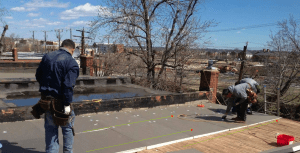Water Drainage Systems for Flat Roofs

Opportunities for a rooftop garden or more outdoor living space are among the most appealing characteristics of a flat roof. Accompanying a flat roof’s desirable aspects, however, are challenges that include roof repair and the efficient drainage of water from heavy rainfalls and storms. Here are the three most common drainage systems for a flat roof.
Gutters Are Easily Installed but Require Maintenance
Gutters are the easiest types of drain systems to purchase and install. They keep water from pouring off the roof, protect window openings and doorways, and prevent water from pooling and rising near the building’s foundation. Gutters require continuous cleaning throughout the year. They can collect leaves from overhanging tree branches, dirt, and debris that, when not removed, render gutters ineffective.
Inner Drains Are Protected From the Elements
Inner drains are installed in or near the middle of a home or building, then attached to pipes that drain water from the roof. Just make sure the roofing materials are correctly attached to the drains. Protected inside the roof and walls, the pipes are not threatened by freezing during winter months. A custom strainer can be made to prevent clogging, but even a slight amount of debris can block it. Keep in mind that inner drains usually require a professional technician for roof repair and maintenance.
Scuppers Can Increase Efficiency
Scuppers are openings in curbs or walls on the outer edges of a flat roof that allow water to drain away. When designed and installed correctly, scuppers form an effective, low-cost water drainage system that requires minimal maintenance. If the scuppers are sufficiently large or wide to handle their buildup, leaves and debris are blown off the roof or steered away from the building. Just be sure scupper runoff does not accumulate near the foundation or a wall.
Flat roofs are appealing for a wide range of architectural and lifestyle reasons. Many homes also have roofs with portions of flat areas, such as garages, porches, and balconies. The key to properly maintaining a flat roof is ensuring consistent water drainage and, if necessary, filing insurance claims when roof repair is required from heavy rainfall or storm damage.
